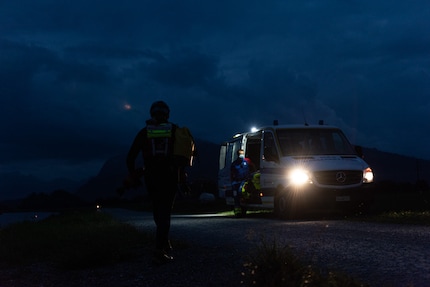
Background information
Are you going swimming safely? The dangers of the Corona summer
by Michael Restin

Members of the SSS spend their free time in the water. Once a month, the Mittelrheintal section trains to keep its cool when the pulse races. A visit to the volunteer lifeguards.
It's a cloudy, rainy day in August. Atypical for this summer under the sign of the coronavirus, which is causing alarm bells to ring among rescue workers: more people are staying in the country during the holidays and visiting remote waterside locations. Which means an increased risk of accidents.
The Mittelrheintal section has already had to intervene five times up to mid-August. "This time last year there were only two interventions," explains Dario Rodi. Fortunately, there were no search missions in 2020. "Three times for rescuing people, twice for technical assistance," he sums up.
A vehicle in the canal, a recovery of material goods. A swimming accident, a person in the Rhine, a suicidal person who wanted to jump off a bridge. "This unfortunately happens on a regular basis."
The interventions are not all spectacular. The SSS also provides bathing surveillance and safety at events, courses and a lively community life. It is more than "just" lifesaving, and well integrated: "Since 1982, the SSS has been a proud member of the Swiss Red Cross," reads a statement about the association.
It takes time for a rescue swimmer to be fit to be part of the intervention section that responds to emergencies. "22 people are informed in the event of an alarm, two or three are on their way," explains Dario Rodi. "Basic training is done in-house, then there are intervention exercises and intervention training."
To be part of it, it's not enough to know how to swim well. Dario Rodi shows search poles, boxes with technical equipment, ropes and abseiling gear. Tools with which rescue swimmers need to be familiar. Depending on the situation, different qualities are required: "In principle, we are generalists, but we have different levels of experience," explains Dario Rodi.
"Water rescue! Get out! No further!" can be heard all the way to Austria. A fully-dressed team has stationed itself on the shore. The man in the water, visibly unimpressed, continues to crawl a few fathoms towards the middle of the river. Then he stopped moving, drifting inert on his stomach. Splash, a dive. The lifeguard moves towards the man, grabs him and turns him over.
Using the rope from her lifejacket, her colleague on land manages to pull them both very slowly out of the current towards the shore. About fifty metres further on, they are met by the second station. It sounds simple, but doesn't always work in the dynamics of the moment.
Timing is difficult in the strong current. It's quite an art to jump at the right moment to reach the casualty quickly. If they fail to do so, the cry "End of rope! Swim!" sounds and no one can pull, making the rescue more complicated.
Those who train are more likely to react correctly in exceptional situations. There are no guarantees, every intervention is different. "Things must and can go wrong," says Dario Rodi of training. "It's the only way to improve. My key word. I'm also allowed to act as a "patient": I put on my swimming costume and neoprene to float in the water. Rescuers don't talk about "victim" while there's still hope.
Very calmly, we make our way step by step into the water. Daniela Lippuner shows me a stone suitable for jumping into the Rhine and reminds me of the "passive position" in which I should let myself float after a few crawl movements. Sitting in the water, feet first, I wait to be rescued. The way out seems trickier than the way in: the current and the rocks in the shallow water are traps. Anyone who gets their foot stuck here has a problem.
In an emergency, I depend on someone to react and alert the rescuers. "118 would be the right number, 144 works of course too," explains Joël Rodi, who has taken up position next to the water rescue vehicle and is taking stock of the situation at the scene. "In the waterways, we have the Alpenrhein rescue concept," he says, referring to the map on one side of the vehicle, which contains place names and landmarks such as bridges.
"These are the number of the water rescue vehicle.
"These are numbered and we have sections," he explains. "If someone is in distress, we trigger an SOP and the incident commanders meet on the next bridge."A safety post is set up at the limit of the section, "which ensures that, according to our defined reaction time, the patient has not yet passed."At the same time, on the situation map, the evolution of the situation is noted.
A look at the management structure shows the importance of communication. The police, fire brigade and health services are the partner organisations, joined by Austrian colleagues in the border waters. "From the event to the management of the response, via the alert and the journey, it's a standardised process," explains Joël Rodi. A major deployment that can only be managed in this way.
In an emergency, everything has to work perfectly, everyone has to know what he or she has to do and concentrate on their individual task. "After the intervention, we have a kind of debriefing, called defusing," explains Joël Rodi. "The intervention forces do this themselves as a team. It's about establishing an equality of information."
You only have to climb into the lifeboat with Kevin Berger to realise the extent to which one task absorbs all attention. Launching over the embankment is difficult enough, but at full speed, the sensory impressions jostle for attention. The current and the waves, the boat and the horizon move at breakneck speed to form a wobbly overall image.
Simple writer and dad of two who likes to be on the move, wading through everyday family life. Juggling several balls, I'll occasionally drop one. It could be a ball, or a remark. Or both.
Interesting facts about products, behind-the-scenes looks at manufacturers and deep-dives on interesting people.
Show allThe Rhine can be wild, cold, tumultuous and potentially deadly. But sometimes, Dario Rodi finds that this grey river displays a special magic in the dark: "In winter, when you step on a fresh layer of snow before entering the water, there's something magical about it," says the regional president of the Swiss Lifesaving Society Eastern Region, with a smile behind his mask. In passing, the phrase says a lot about the state of mind of the men and women who meet once a month to train for rescue operations. In the evening, in their spare time, whatever the weather.
Being active in the SSS is neither a hobby nor a profession, but rather a vocation. "I was in contact with the SSS from an early age, through my parents," explains the 33-year-old. After qualifying as a young lifeguard, one thing led to another: "I've been active for 20 years now, and I've become more and more involved". In the meantime, the structures have become professional and the commitments serious. The lifeguards work alongside the fire brigade, the police and the health services. "Since 2017, we have been part of the alarm organisation of the canton of St. Gallen and can be called directly by the cantonal emergency call centre," explains Joël Rodi, Dario's brother. He is president and head of operations of the Mittelrheintal section. Just as thoughtful, just as structured and just as committed.
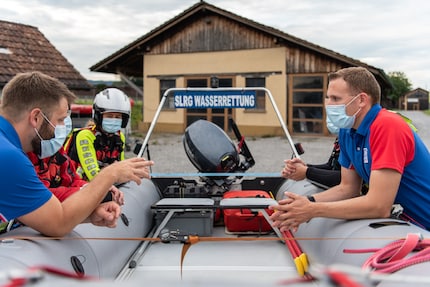
The members of the response section, which has been in existence since 2013, have to be prepared for different scenarios. In the event of a water accident, every second counts. Like time running out in an hourglass, the minutes spent in the water mercilessly absorb the body's energy. Beneath the surface, hope quickly fades and the rescue mission becomes a search mission with a tragic outcome. On rivers, the situation is all the more complicated because it is constantly changing. "Problems on the Rhine usually work against us," explains Dario Rodi, looking at the section's area of operation. It stretches across the St. Gallen Rhine valley, from Lake Constance to Rüthi.
To respond appropriately, tasks need to be clearly divided, both for the men and women in the water, and among those responsible for intervention. The latter meet the challenges with a SOP, "Standard Operating Procedure" and clearly defines the procedures. As in any place where time is of the essence, the language of the SSS is full of abbreviations. At HQ in Widnau, between the A13 and the Rhine, a rescue boat, a quad bike as a rapid intervention vehicle and a large water rescue vehicle are waiting to be used.
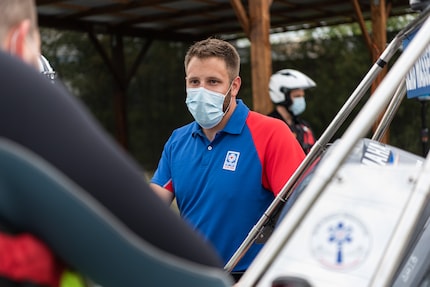
Whatever happens, the start has to be quick. "In ten to fifteen minutes, a team is ready on the rapid response vehicle". Torn away from the office or private life, the team soon sets off in full gear on the all-terrain quad to an uncertain intervention. The water rescue vehicle follows. A minibus in which the incident commander travels with his team and can transport the boat or raft by trailer. Members of the SSS do not get time off work for this. They have to carry out their mission in their own time, compensating for it with holiday or overtime.
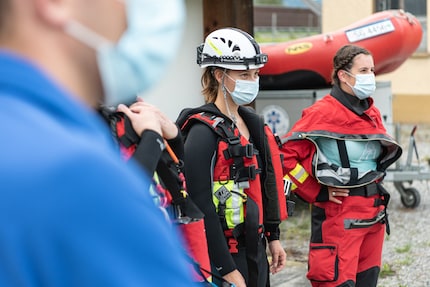
While Rodi presents the equipment and lectures on the structures, more and more men and women find their way to HQ. They prepare their equipment, slip into neoprene suits, prepare themselves and the equipment with routine gestures. While the first on the scene seemed to fit the cliché of the great male rescuer, at 7pm five women and six men stood in a circle for the briefing. "Because of the coronavirus, we train in small groups", explains a masked woman; but the proportion of women is representative.
Today, contact rescue with waistcoat and rope is on the programme, with the designated training venue being the bridge of the Mäder customs office. "Good access, around 70 metres wide, constant conditions", sums up Dario Rodi. But the most important value for assessing the situation is different: "The flow in cubes per second is decisive for us," he explains. "If I say 800 cubes, the others know". Short messages, nods; here, everyone knows what to do. When it comes to getting in the water, the atmosphere is relaxed. Training is training, and it's clearly a pleasure.
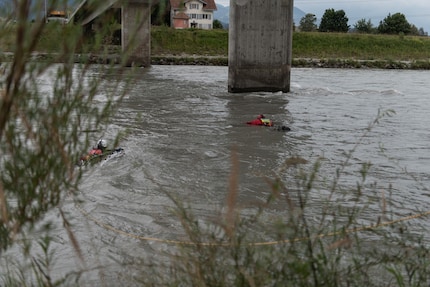
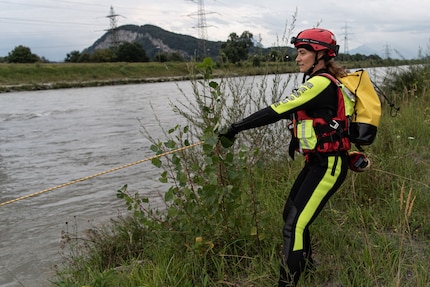
Every summer, people drown trying to help and risking their own lives. "You really have to think twice if jumping is worth it," says Dario Rodi when asked about this tragedy. Nobody should put themselves in danger. If possible, launch a means of rescue, keep an eye on the person and report their exact position; that's the right thing to do in an emergency. "Rescue with minimum risk." is the principle. Less Alert to Malibu, more common sense. The most important thing in a rescue is to protect yourself.
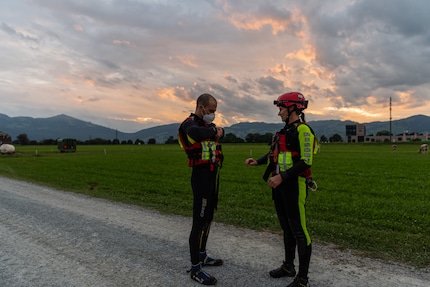
"Don't get up until you're told to," Daniela instils in me. "We're going to pull you out of the water. When you're out and everything's fine, you put your fist to your head", to show the others that everything's fine. In this case, don't panic. Eleven lifeguards, a lifeboat, the rapid response vehicle and the water rescue vehicle should be enough for me. You've rarely seen anyone jump into the Rhine with better protection. Kathrin, a chemical laboratory technician by profession and active for three years, easily pulls me out of the water.
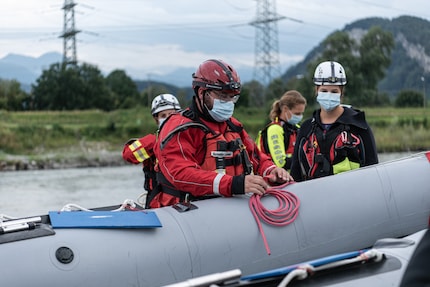
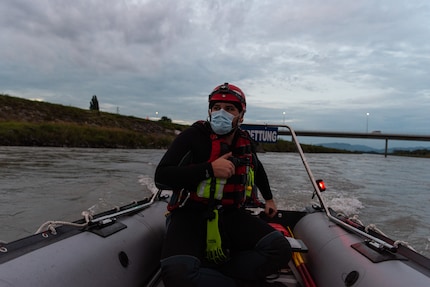
As a passenger in training, it's a real pleasure. But in real situations, it's stressful for everyone involved; whatever their function. Stress that will certainly be easier to manage if the outcome is favourable. But what if all the help comes too late? Who helps those who help? "In the event of a problem, we can debrief with external people who conduct a guided interview to help you take stock," explains Joël Rodi. "Psychological support is also available. The complete package, then.
While most of us turn into sofa heroes after work by turning on Netflix, the rescue swimmers throw their skills into the mix together to thwart fate. They jump into the water, capsize in rafts, abseil, drift in the dark in summer and winter and exhaust themselves in rescue drills. With enthusiasm for the cause, and with an eye to emergencies. As dusk falls over the Mäder customs post, headlamps still flicker on the water. The image has something symbolic about it. The men and women of the SSS are pushing the boundaries, in the truest sense of the word.
